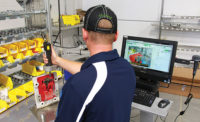When walking, the interaction of muscles and veins creates the venous pump, forcing blood back to the heart from the legs. Gravity causes blood to settle in the feet and leg when standing for long periods due to the decreased effectiveness of the venous pump. In the short term, workers get aching legs due to increased pressure on the walls of the veins. Over the long term, this pressure can lead to swelling, pain and potentially permanent circulatory damage in these extremities.
Anti-fatigue mats should be considered for assembly tasks that require operators to stand in one place for long periods of time. Standing on a mat stimulates muscle activity in the feet and legs to aid the venous pump. "Not only the material but the surface design stimulates muscle activity in the lower extremities," explains Torsten Rodbroe, president of Ergomat (Westlake, OH), a manufacturer of anti-fatigue mats.
Rodbroe claims that the elastic properties of the polymer in anti-fatigue mats resemble the natural springiness of a uncompacted soil, such as a farm field. Every foot movement on the mat is absorbed by the microcellular foam construction in the mats to reduce any impact effects. It springs back to deliver that small amount of energy back to the feet. Unlike soft mats, the polyurethane retains its elasticity over time.
Surface profiles in anti-fatigue mats usually feature a bubble or cone design that provides a massaging effect on the feet. "All these pressure points move up and down as the worker shifts his weight," explains Rodbroe. "The action of the mats increases his comfort so he can work longer without being restless, and will not be focusing on his next rest break or how long before he gets to go home."
Different mats suit different assembly environments. "It is not a situation where one product equally suits everybody," says Rodbroe. Selection of either polyurethane or nitril rubber mats depends on the working environment. Polyurethane can absorb liquids, making nitril rubber mats a better choice in messy environments. Nitril is also more resistant to damage by hot-metal shavings than a polyurethane mat.
In addition to Ergomat, other companies that market antifatigue mats include ErgoSource (Wayzata, MN), R.C. Musson Rubber Co. (Akron, OH) and Sunnex Inc. (Natick, MA).



